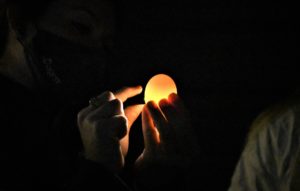Texas A&M poultry students work, learn at research facility
Program adds experience, perspective to classroom lessons
Texas A&M University graduate student Kristin Moncada is on her career path in poultry science and is helping other students access a unique experience within the industry.

Moncada, a doctoral candidate in the Texas A&M College of Agriculture and Life Sciences Department of Poultry Science, manages the Pilgrim’s Breeder Performance Center in Pittsburg, Texas. Every six months Moncada opens the facility up to undergraduate and graduate students for some hands-on experience.
It’s a trade of sorts, Moncada said.
The students get a week of experience in the field. They tour several Pilgrim’s operations, including Moncada’s European-style research facility, cover young hen management, breeder hen production, egg quality and fertilization concepts, and meet with professionals and executives within the industry for networking and knowledge-sharing.
In exchange, Moncada, who works and manages the three-house 30,000 bird facility with two Pilgrim’s employees, gets helping hands for a labor-intensive sorting process. The only one of its kind in the U.S., this European-style poultry production method is being tested for commercial efficacy.
The program started as a way to assist Moncada’s research at the experimental breeder site while giving students, who rarely get experience outside classrooms, an opportunity to see traditional and experimental poultry concepts at work.
Inside access to industry practices
In general, Moncada said the biggest difference between European-style houses and traditional commercial houses in the U.S. are community nests, which allow hens to lay eggs in large group nests. This practice reduces competition among the hens for individual nests.
Another European component researched at the facility is everyday feeding and sorting pullets for weight management, she said. Moncada needed volunteers to sort the pullet flock by manually weighing and moving 4-week-old birds into areas with similarly weighted birds so she can control their diets. By moving lighter-weight birds, she can provide feed amounts that will maximize their production. It also reduces bird stress by reducing feed competition within the flock.
“The whole purpose of this farm is to take management practices proven to work globally and adapt them to production here in the U.S.,” she said.
This was the third time poultry students have visited the experimental breeding facility. Moncada said the experience helps students gain a well-rounded understanding of poultry production and potential career paths within the industry.
Graduate student Garrett Powell, who was among the 13 undergraduate and three graduate students to recently visit the farm, said gaining access to Pilgrim’s facilities and knowledgeable poultry insiders was well worth the work.
“Being inside operating houses gives you a new perspective that a classroom can’t,” he said. “This kind of access is really unprecedented in the industry.”

Audrey McElroy, Ph.D., Department of Poultry Science head and Texas A&M AgriLife Extension Service poultry specialist, Bryan-College Station, said student access to the farm adds a unique value to the poultry program for a few reasons.
First, students gaining access to working farms or research farms outside of a university system is very rare. Secondly, the Pilgrim’s site is the only European-style breeder facility in the U.S.
McElroy hopes the student program can become a part of the poultry department’s curriculum in the future. She said the practical hands-on experience could give students an advantage in a global job market while introducing them to new technology and new concepts that could improve the industry for the animals, the growers and ultimately consumers.
“I see really good potential there,” she said. “It’s been a mutually beneficial partnership so far, and the fact that these research houses have the potential to impact how poultry production in Texas and the U.S. evolves into the future, it makes it that much more appealing from an education standpoint. The students who visit that site are reinforcing traditional concepts taught in classes, but they are also learning about global methods. Providing that perspective is unique to Texas A&M, and for the department, that is exciting.”
Potential change in poultry production
Moncada hopes the research houses will impact Texas and U.S. poultry production and encourage nontraditional concepts she believes can improve animal welfare, production efficiency and facilities’ environmental footprint.
She approached Randy Stroud, Pilgrim’s head of global operations, in 2018 at a networking event to discuss the focal point of her graduate studies – animal health and welfare.
Stroud had been in the process of constructing the Breeder Performance Center and researching its foundational concepts. When Stroud and Moncada met, it was evident that Moncada’s passion for animal welfare and innovation aligned with Stroud’s goals for the center.
Moncada’s success so far has expanded the facility’s capacity. With the help of the students and industry partners like Aviagen, which supplies the birds, and Big Dutchman and Chore-Time, which supply technology used in breeder houses in Europe and Mexico, she is cautiously optimistic about the concept’s application in domestic commercial poultry production.
“We’re learning as we go,” she said. “We can’t expect our growers to accept these concepts without determining if they work. Their farms are their livelihood. But Pilgrim’s made an investment in an idea, and this partnership with Texas A&M has made it viable. I hope it can keep expanding and grow into something that benefits everyone involved.”


